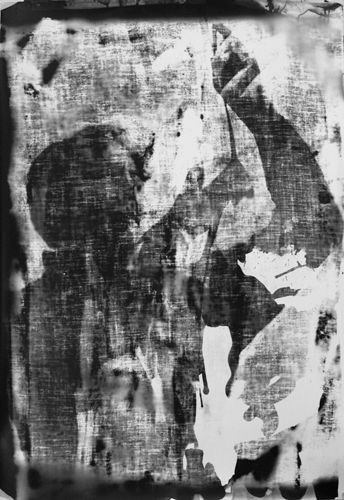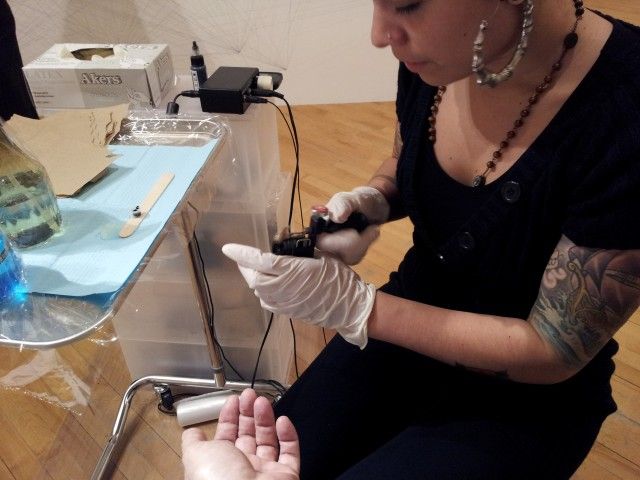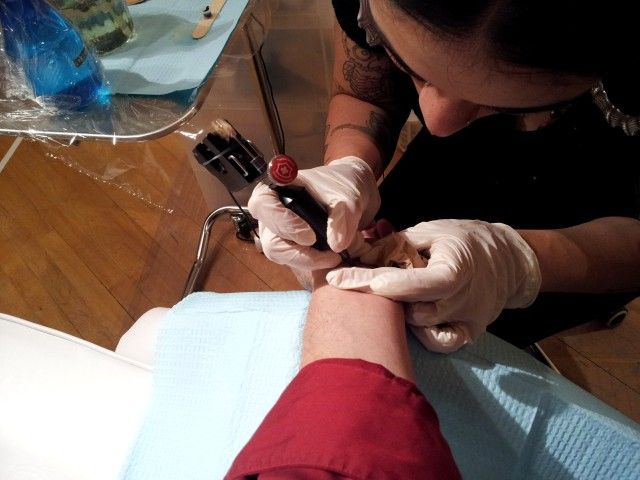Museum of Fine Arts. During the performance, I received a small tattoo.
I'll explain more, but I'm way behind in telling you of other art shows I've been attending. It's been
a fun few weeks!
First, there was Ori Gersht's "History Repeating," at the MFA. (http://www.mfa.org/exhibitions/ori-gersht)
The best, and worst, of the exhibit can be summarized in this:

It's a striking image, and takes a moment to decipher: It's a dead pheasant being dropped
head-first into a pool of still water.
The image is arresting, but it's also very false because that's just one frame from a 5-minute
video of the bird suspended over the water, then falling in extreme slow motion. Much of
"History Repeating" is made up of slow motion videos. The still, above, does not exist in that
form in the exhibit; it flashes by in 1/60th of a second, just as one frame of a too-long video.
In another long, slow video, Gersht had dipped a bunch of flowers into liquid nitrogen, and set
the flowers --- stiff and smoking with condensed water vapor --- in a vase. The video starts, and
nothing happens for long minutes. Then, a small bit of plastic explosive goes off, shattering the
frozen flowers and the vase. The shrapnel slowly fills the frame, and dissipates.
The videos have the feel of a student playing with a new high-speed camera. The technique
might have been new to Gersht and to the staff at the MFA who approved and mounted the
exhibition, but videos like that have been around since the 1940's, when ultra-high-speed
photography was invented across the river here, at MIT. There's nothing new or innovative in it.
Gersht's one contribution was in how he composed the original setups: they have a somewhat
painterly feel to them. But he desperately needed an editor, or advisor, or better muse, to help
him find the grains of wheat --- the few interesting stills --- amidst the chaff of too-long videos.
Instead, he just pushed the camera's Record button, and let events unfold.
The exhibit also included some paintings of his and a few very large format still photos (I liked
those). But in all, I thought the whole thing was rather crude and inartful.
On the other hand, Simmon's College's Trustman Gallery's Nature Vive and Nature Morte
(http://www.simmons.edu/trustman/exhibits/230.php) was exquisite. An example:

The exhibit was a series of pieces --- photos, oils, sculptures/installations --- by four very
different artists.
The one above is by Mary Dondero who is exhibiting "two bodies of work, flower photographs
and ink paintings. Flowers are a traditional symbol of the term Vanitas, or the transience of
existence. Our throat catches as we look at these intimately delicate blooms that are sewn,
bound or pulled to pieces. Her larger-scale ink drawings are masterfully chaotic, while
controlling and releasing energy. Their deft touch and spontaneity call to mind the Zen painting
masters of Japan."
OK, description is a little florid, but the photos are stunning, and worth seeing if you're in
Boston. (The Trustman gallery is free and open to the public.)
The other works on display there are also interesting, but I have to say the Dondero flower
photos knocked my socks off.
Also at the MFA: Mario Testino: In Your Face (http://www.mfa.org/exhibitions/mario-testino).
If you've ever wished you could be trapped in four giant rooms filled with R-rated versions of
images ripped from the pages of Vogue, People Weekly, and checkout-counter tabloids, this
exhibit's for you.
It wasn't, for me.
I blew through the exhibit in about 10 minutes, incredulous the whole time.
The Boston Globe was ambivalent about the exhibit. One article praised it for breaking the
sometimes-stuffy mold of a very old art museum. OK, I can see that. But another article
paralleled my reaction: WTF do celebrity candids have to do with art?
Yes, some of the photos are carefully composed, lit, and staged. Some are in very large
formats, and thus show a mastery of the mechanics of photography. But most are just plain old
candid shots, exactly like the ones you see in the checkout-counter magazines at the
supermarket.
In fact, a number of the photos in the exhibit were originally shot for and appeared in various
magazines. It's just skillful commercial photography, not Art.
Harvard's Carpenter Center For The Visual Arts is showing Matt Saunders: The movies that
were secret remain secret somehow and a nation forgets its pleasures.
(http://www.ves.fas.harvard.edu/saunders_ccva.html)

"Artist Matt Saunders creates a project for the site-physical, historical and programmatic-of the
Harvard Film Archive. Fleeting, hand-drawn shorts screen in the theater during the day when
the Archive sleeps, while interventions in the displays and other crannies of the HFA deploy
both still and moving image."
He's taken various film clips and stills, retouched them by hand (and, I suspect, by rotoscope) to
remove most of the detail, reshot them in black and white, and processed the hell out of them
so that gray midtones remain more or less stable, but white-whites and black-blacks invert
several times a second, creating a weird, seizure-inducing positive/negative stroboscopic
effect. Some of the images are recognizable; while others are fragmentary and/or on the
screen so briefly you can feel your brain working overtime to try to make sense of what your
eyes are reporting. There's a sense of a pattern being almost there, just out of reach.
This film is currently being shown every day from 12-1p --- it's a 10-minute film that loops
endlessly. It's probably worth seeing if you're in the Harvard Square area around lunchtime,
have 10 minutes free, and aren't prone to epilepsy. The CCVA is free and open to the public.
Something Along Those Lines and Mnemonic are two related exhibits at Boston's
School of the Museum of Fine Arts. (http://www.smfa.edu/something-along-those-lines)
Something Along Those Lines is an exhibit whose centerpiece is a recreation of a collective
work produced in 1971: "SMFA hosted Sol LeWitt as a visiting artist and lecturer. Not a fan of
public speaking, LeWitt instead invited students to work with him on a new piece, Wall
Drawing #118, comprised of 'fifty randomly placed points all connected by straight
lines,' his first wall drawing in Boston. Wall Drawing #118 was drafted and installed again this
fall by SMFA students, serving as the catalyst for 'Something Along Those Lines,' a dynamic
group exhibition which brings together artists who combine conceptual, sculptural and
performative engagements with the formal elements of drawing."

LeWitt's Wall Drawing #118: Fifty random points all connected by straight lines (above) also is
the inspiration for "Mnemonic," the performance piece by Katrina Chamberlin, for which I
volunteered.
In it, an artist tattoos a small black dot on the body part of choice of some volunteers, while
being photographed for later display. When the performance concludes, there will be 24 people
walking about Boston with small black dots --- mine is on the inside of my left wrist ---
connected by the common thread of having volunteered to be a part of a performance art piece.


She calls it Mnemonic, but as a film buff, I prefer to think of it as a Memento of the event. :)
Well...art is in the eye of the beholder...or is that beauty?
ReplyDeleteSo candid photographs is not art, but connecting dots with lines and tattooing people is art?
I'm wondering about all of these.
Peace,
Randy
Art is very subjective. But I think Art is any deliberate work that makes you think of something deeper, beyond the immediate object or performance before you. Art tries to illuminate something deeper.
ReplyDeleteSome legitimate attempts at art fail, but still get hung in galleries. There's nothing wrong with trying something noble, and failing.
But there's also a lot of stuff that's presented as Art that's really just posing and pretense and BS and money-making and self-promotion.
I think the "50 points" piece is Art; it's a collective work of 50 independent people; each one's dot is as important as the next; each is connected to all the others through the faint pencil line and the shared experience. In a way, it's a very direct allegory of the human experience; us all as equally-important, interconnected social creatures. Everyone counts. Everyone's contribution counts.
I think the "Mnemonic" piece also is Art, for similar reasons. There are 24 dots walking around Boston now; 24 people connected with a small bit of ink and a shared experience. They could be anyone, and everyone, and you can't tell. That's the point, so to speak.
But, of course, you are free to disagree. Art is very subjective. :)
This comment has been removed by a blog administrator.
ReplyDeleteThis comment has been removed by a blog administrator.
ReplyDeleteThis comment has been removed by a blog administrator.
ReplyDelete